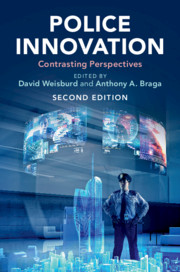Book contents
- Police Innovation
- Police Innovation
- Copyright page
- Contents
- Figures
- Tables
- Notes on Contributors
- Introduction
- Part I Community Policing
- Part II Procedural Justice Policing
- Part III Broken Windows Policing
- Part IV Problem–Oriented Policing
- Part V Pulling Levers (Focused Deterrence) Policing
- Part VI Third–Party Policing
- Part VII Hot Spots Policing
- Part VIII Predictive Policing
- 15 Advocate
- 16 Critic
- Part IX CompStat
- Part X Evidence-Based/ Risk-Focused Policing
- Part XI Technology Policing
- Index
- References
16 - Critic
Predictive Policing: Where’s the Evidence?
from Part VIII - Predictive Policing
Published online by Cambridge University Press: 09 August 2019
- Police Innovation
- Police Innovation
- Copyright page
- Contents
- Figures
- Tables
- Notes on Contributors
- Introduction
- Part I Community Policing
- Part II Procedural Justice Policing
- Part III Broken Windows Policing
- Part IV Problem–Oriented Policing
- Part V Pulling Levers (Focused Deterrence) Policing
- Part VI Third–Party Policing
- Part VII Hot Spots Policing
- Part VIII Predictive Policing
- 15 Advocate
- 16 Critic
- Part IX CompStat
- Part X Evidence-Based/ Risk-Focused Policing
- Part XI Technology Policing
- Index
- References
Summary
Crime analysis is a field of study and practice in criminal justice that utilizes various data sources and analytical techniques to support crime prevention, crime reduction, and criminal apprehension efforts of police agencies (International Association of Crime Analysts [IACA], 2014). Crime mapping is a subset of crime analysis that focuses on understanding the geographic nature of crime and other activity and presents results to a wide range of police audiences through published maps (Santos, 2017). Although there have been crime analysts in police departments since the early 1970s (Austin et al., 1973) and researchers who have analyzed crime for centuries (Weisburd & McEwen, 1997), there has been a notable increase in the last twenty years of police agencies implementing crime analysis, purchasing analytical technology and software, and hiring in-house qualified individuals to conduct analysis – crime analysts.
- Type
- Chapter
- Information
- Police InnovationContrasting Perspectives, pp. 366 - 396Publisher: Cambridge University PressPrint publication year: 2019
References
- 8
- Cited by

